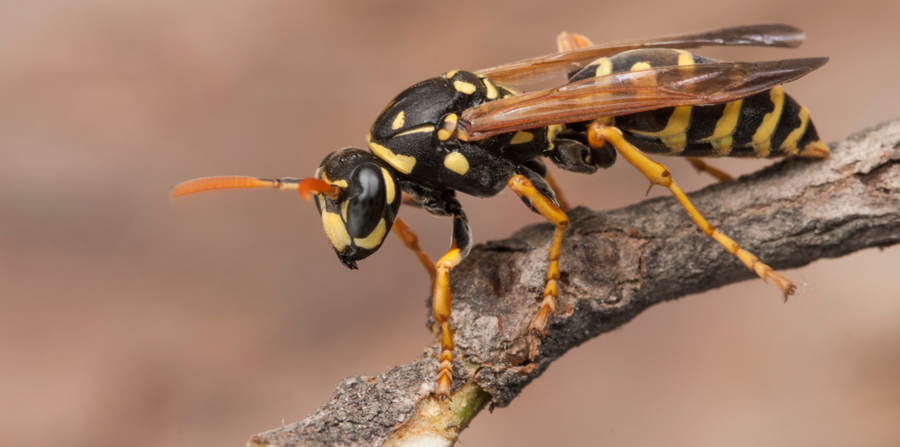As you may have already noticed, it’s officially wasp season here in Michigan. Every summer, the wasp population peaks around July, and the pest becomes far more prevalent than usual. Wasp season begins by late June and continues until around late fall.
But what is “wasp season,” exactly? More importantly: how could it affect you? Here’s everything you should know about wasps in Michigan, including how to keep them away from you.
What are wasps?
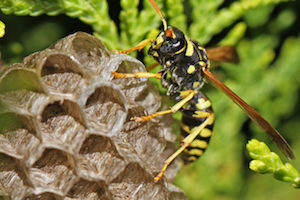 “Wasp” is actually a general term referring to a particular group of related insects in the Hymenoptera order. Wasps are any members of Hymenoptera that aren’t bees, ants, or sawflies. The most common and well-known wasps in Michigan are yellow jackets and paper wasps. Each of these types of wasp (rather infamously) resemble honey or bumblebees.
“Wasp” is actually a general term referring to a particular group of related insects in the Hymenoptera order. Wasps are any members of Hymenoptera that aren’t bees, ants, or sawflies. The most common and well-known wasps in Michigan are yellow jackets and paper wasps. Each of these types of wasp (rather infamously) resemble honey or bumblebees.
Though many types of wasps are solitary, most common Michigan wasps are eusocial, meaning they live together in colonies. Wasps are opportunistic scavengers and predators, feeding primarily on a wide variety of insects. They feed their young by hunting down prey and bringing it back to their nests repeatedly. Wasps are considered beneficial insects because they feed on many common garden pests. Adult wasps feed on natural sugars like ripe fruit, honeydew, and nectar.
What kinds of wasps are in Michigan?
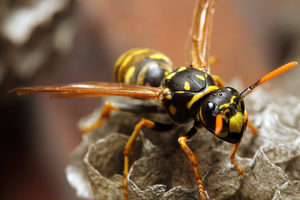 If you encounter a wasp this summer, chances are it will be a eusocial wasp from a nearby colony. Eusocial wasps in Michigan belong to two subfamilies: Polistinae (paper wasps) and Vespinae (yellow jackets). The most common paper wasps in Michigan are the Common paper wasp (Polistes fuscatus) and the European paper wasp (Polistes dominulus). There are twelve types of yellow jacket in Michigan. The most common are the German yellow jacket (Vespula germanica), Eastern yellow jacket (Vespula maculifrons), and Baldfaced hornet (Dolichovespula maculata).
If you encounter a wasp this summer, chances are it will be a eusocial wasp from a nearby colony. Eusocial wasps in Michigan belong to two subfamilies: Polistinae (paper wasps) and Vespinae (yellow jackets). The most common paper wasps in Michigan are the Common paper wasp (Polistes fuscatus) and the European paper wasp (Polistes dominulus). There are twelve types of yellow jacket in Michigan. The most common are the German yellow jacket (Vespula germanica), Eastern yellow jacket (Vespula maculifrons), and Baldfaced hornet (Dolichovespula maculata).
Solitary wasps are not as prevalent as eusocial varieties, but there are still several types you may encounter. Cicada killers (Sphecius speciosus) are large digger wasps that nest on the ground. Mud dauber wasps like the Black and yellow mud dauber (Sceliphron caementarium) build nests in the mud. The invasive European woodwasp (Sirex noctilio) bores into the trunks of dead or dying trees. Paper wasps, yellow jackets, cicada killers, and mud daubers can all sting, but woodwasps cannot.
When are wasps most active?
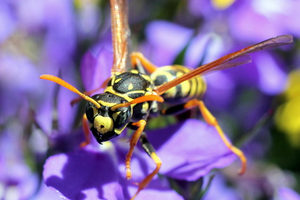 Eusocial wasp colonies reach peak activity in midsummer. They spend spring and early summer looking for a good place to nest, laying eggs, and producing workers. The colony continues to ramp up its population growth aggressively through the summer. By July, colonies have produced hundreds of workers. These workers spend each day hunting for food to bring back to the nest. If there’s a nest near your home, you might encounter workers regularly during this period of colony development.
Eusocial wasp colonies reach peak activity in midsummer. They spend spring and early summer looking for a good place to nest, laying eggs, and producing workers. The colony continues to ramp up its population growth aggressively through the summer. By July, colonies have produced hundreds of workers. These workers spend each day hunting for food to bring back to the nest. If there’s a nest near your home, you might encounter workers regularly during this period of colony development.
Wasp activity changes again in very late summer or fall. Eventually, queens stop laying worker eggs and produce a final brood of reproductive king or queen wasps instead. When these wasps leave the nest to build new colonies, the workers no longer have to worry about feeding larvae. Without their colony responsibilities to keep them near their nests, worker wasps range further than usual. They pursue sugary foods they can’t transport more frequently and sting more often, too.
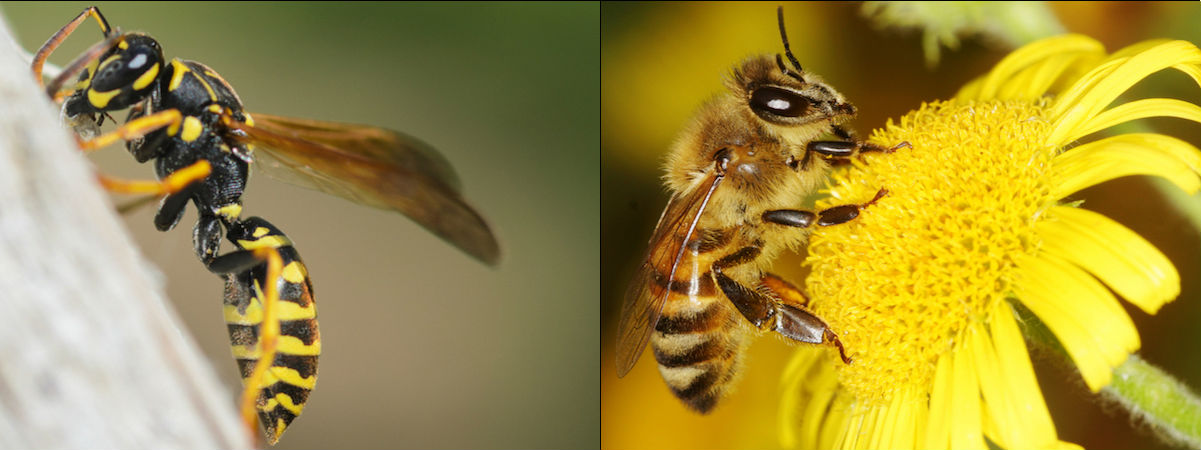
How can I tell wasps and bees apart?
Wasps (left, above) and bees (right, above), especially yellow jackets and paper wasp species, can look very similar. They’re both usually yellow and black, and they both range in size from ½ to 1” long. The easiest way to tell wasps and bees apart is by looking at the “texture” of their bodies. Bumblebees and honey bees look furry or “fuzzy,” because their abdomens are covered in fine, bright hair. Wasps, on the other hand, are hairless. They have hard, shiny, almost metallic-looking bodies that more closely resemble insect exoskeletons.
Wasps and bees also differ in shape, coloration, and behavior. Bees tend to be round or even plump in appearance, whereas wasps are more angular or thin. A bee’s yellow stripes tend to look golden brown or warm, whereas wasp yellow is striking and bright. Bees tend to stay near flowers, to feed on nectar, whereas wasps range to hunt for food. Bee and wasp nests also look very different from one another, because they’re made out of different materials.
How do I keep wasps away from me?
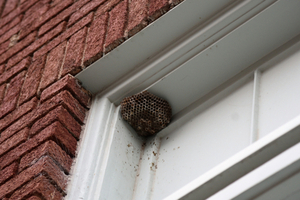 If you run into wasps frequently during mid-summer, it’s probably because there’s a wasp nest nearby. Wasps typically build their nests into existing crevices, burrows, and hiding places. They like to build nests in secluded, covered, or naturally inaccessible locations where they can stay safe. You might find the nest on or under your roof, under a deck or porch, or even in your rafters.
If you run into wasps frequently during mid-summer, it’s probably because there’s a wasp nest nearby. Wasps typically build their nests into existing crevices, burrows, and hiding places. They like to build nests in secluded, covered, or naturally inaccessible locations where they can stay safe. You might find the nest on or under your roof, under a deck or porch, or even in your rafters.
Unfortunately, you might encounter wasps semi-frequently in late summer and fall, even if there isn’t a nest nearby. If that’s happening to you, try looking for reasons why wasps may be attracted to your home. Wasps are very attracted to sugary liquids, especially late in the summer season. Ripe fruit from fruit trees will attract lots of worker wasps looking for a sugar rush. You should also be careful not to leave out garbage uncovered or unrinsed cans and bottles.
Have more questions about Michigan’s wasps? No problem! Just give Griffin Pest Solutions a call any time.

